Grwpiau
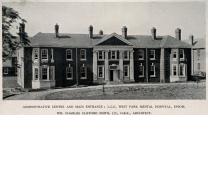
Hospitals
About the group A group for collecting and discussing hospitals, infirmaries, asylums and sanitoria
Wedi ei greu 3 June 2014

Dan Gregory |
||
|
Goodmayes Hospital, Ilford, Essex.
Former West Ham Borough Asylum founded 1898, opened 1st August 1901. Built on a Compact Arrow layout, with a south-facing aspect, the central Administrative Block was flanked on either side with four ward pavilions, one designated for the sick and infirm, another for acute cases, one for epileptic patients and the last for chronic cases. The west side contained 350 beds in 8 wards for male patients, and the east side 450 beds in 9 wards for female patients. There was also an isolation block. In 1918 the Asylum was renamed the West Ham Mental Hospital. The hospital was extended in 1925 and 1928-1934. During the 1930s newer treatments were introduced at the Hospital, including insulin coma in 1937. During WW2 the Hospital joined the Emergency Medical Scheme and four of its wards were converted into an Emergency Base Hospital. In 1948 the Hospital joined the NHS and during the 1950s began to operate an 'open-ward' policy. An Industrial Therapy Unit was also established, aimed at the rehabilitation of chronic patients who had become institutionalised. In 1956 the Hospital had 1,356 beds, reduced to 1,331 in the following year. In 1975 there were 1,087 beds, in 1989, 674 beds and in 1993, 452 beds. The Hospital site is still currently in use, with the laundry, water tower and boiler house providing services also for King George Hospital which relocated to the site in 1993. The original buildings have now mostly been replaced and are likely to be redeveloped as housing. Further reading: http://ezitis.myzen.co.uk/goodmayes.html |

Dan Gregory |
|
|
The Bristol Lunatic Asylum was opened in 1861 in buildings by Henry Crisp.
Originally designed for 250 in-patients, in 1900 (following several extensions by both Crisp and George Oatley) it housed 951 long-term patients (419 male, 532 female). In 1914, the hospital was requisitioned by the War Office to become the Beaufort War Hospital treating wounded soldiers. Apart from 45 patients who were retained to work on the estate, existing mental patients were evacuated to other asylums in the south-west, some as far afield as Cornwall and Dorset. Most of the permanent staff were retained, and were joined by 25 physicians and surgeons and a large intake of nurses. The hospital was returned to civilian use in 1919. In 1948, the hospital joined the NHS and was renamed Glenside Hospital. From January 1993, the co-located Manor Park and Glenside hospitals merged to become Blackberry Hill Hospital. A programme of phased partial closure saw most patients assessed for capability, with many placed within the Care in the Community programme, and others moved into new buildings constructed on the former Manor Park site for long-term care. The former Glenside Hospital campus was bought in 1996 to become the main campus of the University of the West of England's Faculty of Health and Community Studies. See: http://www.glensidemuseum.org.uk/ww1-hospital/ and http://en.wikipedia.org/wiki/Glenside,_Bristol |

Dan Gregory |
|
|
Opened in 1909 by the Metropolitan Asylums Board as the Children's Infirmary, Carshalton Beeches. Queen Mary became the hospital's patron in 1914 and it was renamed Queen Mary's Hospital For Children in 1915.
In 1959, the Fountain Hospital for mentally handicapped children was to transferred to the Queen Mary site to create the first fully comprehensive children's hospital in the United Kingdom. The Carshalton Hospital contracted in size with advances in medical science and moved to the St Helier Hospital site in 1993. Nearly all of the buildings have since been demolished. Further reading: http://www.workhouses.org.uk/MAB-QueenMarys/ |

Dan Gregory |
|
|
Cardiff City Mental Hospital was opened in 1908 by Cardiff County Borough Council in buildings by George Oatley and W.J. Skinner. In 1915, the hospital was requisitioned to become the Welsh Metropolitan War Hospital. It returned to psychiatric use in 1919 but was requisitioned again in 1940, this time as the Whitchurch Emergency Hospital, which closed in 1945. In 1948 the hospital was re-named Whitchurch Hospital and was placed in the care of the Whitchurch and Ely Hospital Management Committee. From 1974 Whitchurch Hospital became the centre of the psychiatric services of South Glamorgan Health Authority and is still open today (2014)
|

Dan Gregory |
|
|
Broadmoor Secure Hospital. Italianate corridor plan buildings by Joshua Jebb, opened 1863 as Broadmoor Criminal Lunatic Asylum. Housed, and continues to house offenders with serious mental health conditions.
Further reading: http://en.wikipedia.org/wiki/Broadmoor_Hospital |

Dan Gregory |
|
|
Stoke Park Colony - Mental handicap hospital built around the Dower House, an Elizabethan mansion with c18th and c19th additions. Established 1908 as part of the 'National Institutions for Persons Requiring Care and Control' by H.N. and K. Burden. Closed 1985-8 and developed for housing with the Dower House was converted to apartments in 1997.
Further reading: http://www.adriankweb.pwp.blueyonder.co.uk/History/Stoke_Park_Colony_CD2.htm http://list.english-heritage.org.uk/resultsingle.aspx?uid=1000129 https://www.flickr.com/photos/brizzlebornandbred/4281678202/ |

Dan Gregory |
|
|
Hampshire County Mental Hospital, compact arrow design by G.T. Hine, 1910-1917. Requisitioned as the No. 4 Canadian General Hospital in 1917 and finally opened to psychiatric patients in 1921. Closed in 1997 with some buildings retained as apartments. Further reading: http://thetimechamber.co.uk/beta/sites/asylums/park-prewett-county-asylum-basingstoke
http://www.victoriacountyhistory.ac.uk/explore/items/park-prewett-hospital-basingstoke |

Dan Gregory |
|
|
East Sussex County Asylum - Hellingly Hospital. Compact Arrow plan buildings by G.T. Hine, 1898-1903. Detail: Chapel, Administration and hospital electric railway.
Further reading: http://thetimechamber.co.uk/beta/sites/asylums/east-sussex-county-asylum-hellingly |

Dan Gregory |
|
|
East Sussex County Asylum - Hellingly Hospital. Compact Arrow plan buildings by G.T. Hine, 1898-1903. Closed in 1994 and mostly demolished 2010-13 with some buildings retained as flats.
Further reading: http://thetimechamber.co.uk/beta/sites/asylums/east-sussex-county-asylum-hellingly |

Dan Gregory |
|
|
Govilon hospital was built by the US Army as 279th Station Hospital. It had 52 wards and 4 operating theatres. The hospital catered for those with serious injuries that the frontline field hospitals could not deal with, such as skin grafts and amputations.
After the war, the camp was used as temporary civilian housing until c1948 but was demolished some time after 1950. Further reading: http://www.coflein.gov.uk/en/site/415429/details/US+ARMY+HOSPITAL,+GILWERN%3B+GOVILON+HOSPITAL/ |

Dan Gregory |
|
|
St Francis' Hospital, formerly Brighton Borough Asylum.
Buildings by H E Kendall Jr., 1859. Opened as the Sussex County Lunatic Asylum and seded to Brighton Borough in 1903. It closed in 1995 and has been converted into apartments. Further reading: http://www.communigate.co.uk/sussex/friendsofstfrancis/page84.phtml |

Dan Gregory |
|
|
St Helier Hospital was founded in 1938 when Queen Mary laid the foundation stone. The building was completed in 1942 but less than a month later was damaged by a bomb and was struck by two flying bombs in June 1944. The hospital remained open, treating many casualties of war from nearby London.
The hospital is still open as a general hospital. |

Dan Gregory |
|

http://en.wikipedia.org/wiki/Horton_Hospital |

Where's Canning Town? |
|

Where's Canning Town? |
||
|
Parc-Gwyllt, Glamorgan County Mental Hospital, opened 1887. Closed 1988, demolished and replaced by HM Prison Parc.
|

Dan Gregory |
|
|
Friern Psychiatric Hospital, further reading: http://ezitis.myzen.co.uk/friern.html
|

Dan Gregory |
|
|
Grove Park Hospital. Former Workhouse built by Greenwich Board of Guardians. Requisitioned as a Mobilisation Camp in WWI and sold in 1919 to the Metropolitan Asylums Board who used it as a Tuberculosis Sanatorium named Grove Park Hospital. Became a mental handicap hospital in 1977 and closed in 1994. Further reading: http://ezitis.myzen.co.uk/grovepark.html
|

Dan Gregory |
|
|
High Royds Hospital opened 1888 as the 'West Riding Pauper Lunatic Asylum'. Buildings by J. Vickers Edwards. Closed in 2003 with some buildings retained as part of a new 'village' development.
|

Dan Gregory |
|
|
Imbeciles Asylum at Leavesden. Yellow brick pavilion-plan buildings, 1868-70 by Messrs. J Giles & Biven for the Metropolitan Asylums Board. Housed persons with senile dementia and learning difficulties.
In 1920 the institution became known as the Leavesden Mental Hospital. The hospital closed in 1995 and was mostly demolished with the exception of the administrative block, chapel and recreation hall. Further reading: http://www.workhouses.org.uk/MAB-Leavesden/ |

Dan Gregory |
|
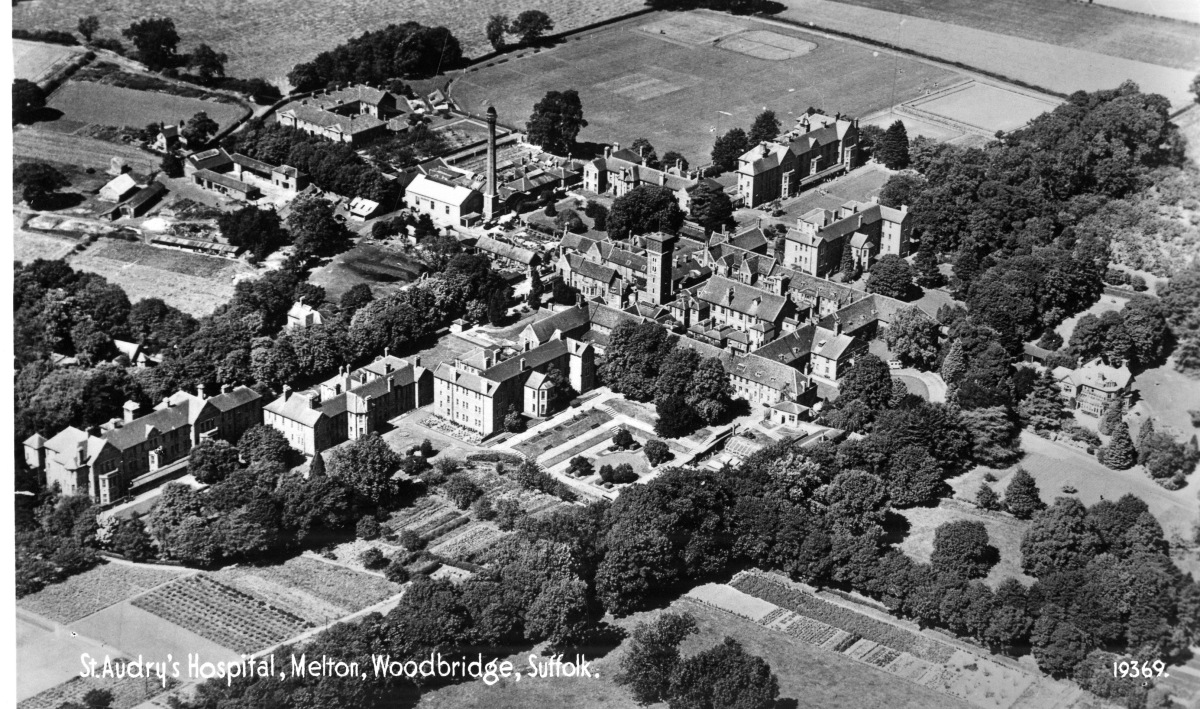
http://laurahaines87.wordpress.com/home/87-2/ |

Where's Canning Town? |
|
|
Leavesden Mental Defectives Hospital and Annexe (later Abbots Langley Hospital) - further information in image comments
|

Dan Gregory |
|
|
Netley Hospital was an army hospital. Demolished in 1966.
http://en.wikipedia.org/wiki/Netley_Hospital |

Where's Canning Town? |
|
|
Tooting Bec Asylum was the fourth asylum hospital to be erected by the Metropolitan Asylums Board to supplement the existing institutions at Leavesden, Caterham, and Darenth. It was intended to accommodate uncertifiable senile patients, infirm epileptics and other 'persons requiring exceptional individual attention'. In 1924 the hospital was renamed Tooting Bec Mental Hospital and became used exclusively for patients with senile dementia. It transferred to the control of the London County Council in 1930 and underwent further expansion, changing its name to Tooting Bec Hospital in 1937. The hospital closed in 1995. All the hospital buildings have now been demolished
|

Dan Gregory |
|
|
Exeter City Asylum - Exe Vale (Digby) hospital
Queen Anne style buildings by Robert Stark Wilkinson, 1886. Became Digby Hospital in 1949 after joining the NHS. Later merged with Exminster and Wonford house as Exe Vale hospital. Closed in 1987 and now converted to housing. |

Dan Gregory |
|
|
Built to a design by Henry Duesbury 1848-1851. The Derbyshire County Asylum was later known as Pastures Hospital. The hospital was closed in 1994 and many of the original buildings have been converted into flats.
|

Dan Gregory |
|
|
The British Army’s first purpose-built hospital, The Queen Victoria Hospital was built 1856-1863. Until 1902, the hospital housed the Army Medical School and treated thousands of wounded servicemen in the Second Boer War, First World War and Second World War.
In 1963, a fire destroyed part of the main building and the hospital was demolished in 1966 with only the chapel being retained. |

Dan Gregory |
|
|
The Royal West Sussex Hospital was opened in 1826 as the West Sussex, East Hampshire and Chichester General Infirmary and Dispensary. In 1913 a grant of King George V renamed the Infirmary The Royal West Sussex Hospital. It continued to serve the public until 1972 when it was closed following the commissioning in Chichester of the new development of St. Richard's Hospital. The building is now divided into apartments
|

Dan Gregory |
|
|
The Bedford County Hospital, now Bedford General Hospital. Built in 1803 to designs by John Wing. Rebuilt 1896-1899 to designs by Salter and Adams.
|

Dan Gregory |
|
|
Planned by Birkenhead County Borough Council as a smallpox hospital, but opened in 1921 as a T.B. sanatorium. It specialised in orthopaedics, treating children suffering from non-pulmonary tuberculosis; and, in the early 1950s, long-stay child patients with psychosomatic conditions, or short stay child patients with mental and physical handicaps. Rebuilt in 1982 as a private hospital called Murrayfield.
|

Dan Gregory |
|
|
Tuberculosis sanatorium by Sydney Tattle for Surrey County Council, 1927-1929. Converted to a psychogeriatric and rehabilitation hospital in 1980-5. The hospital was still open in 2014, but many of the older buildings are now being demolished having been left in a derelict state. Further reading: http://dl.dropboxusercontent.com/u/42366842/Milford/Milford/Milford_Hospital.html
|

Dan Gregory |
|
|
Tuberculosis sanatorium built around Bockhanger Hall, an earlier country house built in 1875 for James S. Burra. In 1913 the estate was purchased by Percy H. Jones who developed it as the Grosvenor tuberculosis sanatorium. The hospital closed in 1955, and was used as a private clinic from 1956 to 1958. In 1961 it was bought by the Metropolitan Police for use as a cadet training school, becoming a Home Office Police training centre in 1973. The centre closed in 2006 following a re-organisation of police training.
|

Dan Gregory |
|
|
Built by the Metropolitan Asylums Board as a Tuberculosis Isolation Hospital in 1922, Highdown Sanatorium, later the King George V Hospital, was opened to treat tuberculosis among London's poor and working classes. In 1941, a large hutted military hospital was added to the site and housed St. Thomas' Hospital, temporarily evacuated from London. The hospital closed in 1988 and was demolished in 1997. The Hydons estate was built on the site. Further reading at: http://dl.dropboxusercontent.com/u/42366842/Teebeeland/KGV/KGV_History.html
|

Dan Gregory |
|
|
The Princess Elizabeth Hospital for Children was founded in 1934 to care for sick children from London. Construction suffered setbacks due to a fire and the outbreak of war and the hospital was not officially opened until 1948.
In 1973 the hospital became a satellite of the Manor Hospital in Epsom and was used as a hospital for mentally handicapped patients. It closed in 1998 and has now been converted to luxury apartments. |

Dan Gregory |
|
|
Netherne Psychiatric Hospital
The Surrey County Asylum at Netherne was built 1907-9 to designs by George T. Hine, to alleviate overcrowding at the County Asylum at Brookwood, Woking. Renamed Netherne Mental Hospital in the 1920s. The hospital pioneered art therapy and psycchosurgery techniques. It closed in 1994 and some of the buildings have been incorporated into the new village Netherne-on-the-Hill |

Dan Gregory |














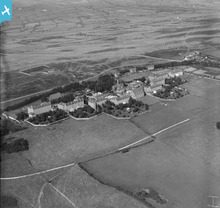





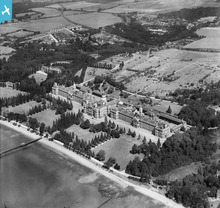
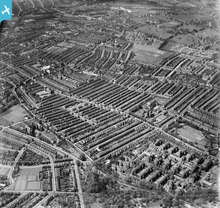


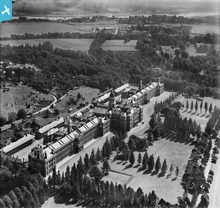








see image record
Opened in 1936, Leybourne Grange Colony housed patients termed 'mentally defective' i.e. persons with severe learning difficulties. The hospital housed up to 1,200 patients, both children and adults. The buildings were centred around Leybourne Grange, a Victorian mansion originally built for Sir John Hawley.
Other buildings included dormitories, a main hall that doubled as a church on Sundays, a nurses’ home and a hospital wing.
The hospital closed in 1996 and the site is now occupied by the Leybourne Chase housing development with the Manor House, clock tower and a few outbuildings being retained.